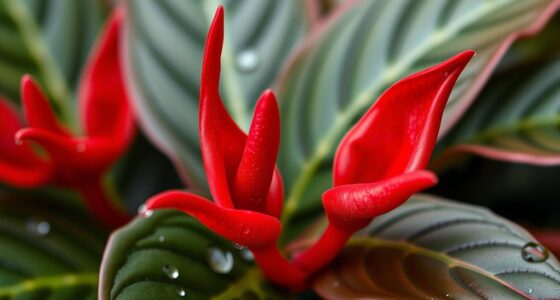To care for your heartleaf philodendron, water when the top inch of soil feels dry, ensuring proper drainage to prevent root rot. Prune dead or leggy stems to promote fuller growth, making cuts just above nodes. Train vines on trellises or moss poles with clips to encourage upward or cascading growth, and regularly shape the plant for a neat appearance. Maintaining consistent moisture and proper pruning will help you achieve a lush, healthy plant—discover more tips to optimize your care.
Key Takeaways
- Water when the top inch of soil feels dry, avoiding overwatering to prevent root rot.
- Prune dead or leggy stems regularly to promote bushier growth and maintain shape.
- Train stems on trellises or moss poles using ties or clips for vertical growth and support.
- Control plant size by trimming tips and pruning to encourage fuller, healthier growth.
- Ensure proper drainage and use clean tools for stress-free pruning and overall plant care.

The Heartleaf Philodendron is a popular houseplant known for its attractive, heart-shaped leaves and easy-care nature. To keep it thriving, you need to establish a consistent watering schedule. These plants prefer their soil to stay slightly moist but not waterlogged. During the growing season, typically spring and summer, water when the top inch of soil feels dry. In the cooler months, reduce watering frequency, allowing the soil to dry out more between waterings. Overwatering can lead to root rot, so always check moisture levels before watering. Using room temperature water helps prevent stress, and ensuring proper drainage is essential to avoid excess water sitting at the bottom of the pot.
Pruning plays a critical role in maintaining the plant’s health and shape. You should prune your Heartleaf Philodendron regularly to remove dead or yellowing leaves, which can harbor disease and pests. When pruning, use clean, sharp scissors or pruning shears to make clean cuts, minimizing stress to the plant. Cutting back leggy or overgrown stems encourages bushier growth and can help control the plant’s size. If you notice stems becoming unruly or trailing too far, prune just above a node—where leaves emerge—to promote new growth from that point. Don’t be afraid to prune heavily if needed; the plant responds well to trimming and can even be propagated from cuttings.
Training your Heartleaf Philodendron involves guiding its growth to suit your space. You can train it to climb a trellis or moss pole by attaching the stems gently with plant ties or clips. This method not only creates a lush, vertical display but also encourages healthy growth. Alternatively, if you prefer a trailing look, allow the vines to cascade from hanging baskets or shelves. Regular pruning helps manage the length and encourages fuller, more vigorous growth. If you want a more compact plant, prune the tips of the vines to promote bushiness. Training and pruning go hand in hand, giving you control over the plant’s shape and size while keeping it healthy.
Frequently Asked Questions
How Often Should I Prune My Heartleaf Philodendron?
You should prune your Heartleaf Philodendron every 4 to 6 weeks to maintain plant health and encourage bushier growth. Regular pruning helps remove dead or yellowing leaves and prevents the plant from becoming leggy. Keep an eye on new growth and trim as needed to shape the plant and promote healthy development. Consistent pruning not only keeps your plant looking great but also supports its overall importance.
Can Heartleaf Philodendrons Tolerate Low-Light Conditions?
Yes, your Heartleaf Philodendron can tolerate low-light conditions, but it prefers bright, indirect sunlight for ideal growth. Indoor lighting that’s too dim may cause the leaves to yellow or grow more slowly. To keep it healthy, place it near a window with filtered light or in a well-lit room. Remember, while it tolerates low-light, providing some sunlight improves its overall appearance and energy.
What Are Common Pests That Affect Heartleaf Philodendrons?
Imagine you notice tiny brown spots on your Heartleaf Philodendron’s leaves—that’s likely spider mites. These pests can be common, especially in dry conditions. To prevent them, consistently inspect your plant and keep humidity high. If pests appear, use natural remedies like neem oil or insecticidal soap. Regular pest prevention is key to keeping your plant healthy and thriving, avoiding infestations before they become severe.
How Do I Propagate Heartleaf Philodendron Effectively?
You can propagate your heartleaf philodendron through cuttings propagation. Take a healthy stem with several leaves and cut just below a node. Remove the lower leaves and plant the cutting in well-draining soil, choosing a soil selection that retains moisture but drains excess water. Keep the soil moist and place the cutting in bright, indirect light. Roots should develop within a few weeks, establishing a new plant.
Is It Safe to Keep Heartleaf Philodendron Around Pets?
You should keep your heartleaf philodendron away from pets, as it poses a risk of pet toxicity. If your furry friends nibble on it, they could experience symptoms like swelling or difficulty breathing. To guarantee safety, place the plant out of their reach and monitor their behavior around houseplants. Always follow safety precautions, and if you suspect poisoning, contact your veterinarian immediately.
Conclusion
Now that you know how to care for and train your Heartleaf Philodendron, you’re ready to watch it thrive. Its delicate, trailing leaves contrast beautifully with its resilient nature—like a gentle whisper amidst strength. With a little attention, it’ll grow lush and vibrant, bringing life into your space. Embrace the journey, enjoy the process, and let this charming plant remind you that beauty often blooms in the simplest things.









